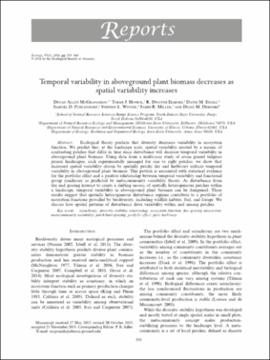| dc.contributor.author | McGranahan, Devan Allen | |
| dc.contributor.author | Hovick, Torre J. | |
| dc.contributor.author | Elmore, R. Dwayne | |
| dc.contributor.author | Engle, David M. | |
| dc.contributor.author | Fuhlendorf, Samuel Dean | |
| dc.contributor.author | Winter, Stephen L. | |
| dc.contributor.author | Miller, James R. | |
| dc.contributor.author | Debinski, Diane M. | |
| dc.date.accessioned | 2019-08-22T17:50:55Z | |
| dc.date.available | 2019-08-22T17:50:55Z | |
| dc.date.issued | 2016 | |
| dc.identifier | oksd_mcgranahan_temporalvariabi_2015 | |
| dc.identifier.citation | McGranahan, D. A., Hovick, T. J., Elmore, R. D., Engle, D. M., Fuhlendorf, S. D., Winter, S. L., Miller, J. R., & Debinski, D. M. (2015). Temporal variability in aboveground plant biomass decreases as spatial variability increases. Ecology, 97(3). https://doi.org/10.1890/15-0906.1 | |
| dc.identifier.uri | https://hdl.handle.net/11244/321245 | |
| dc.description.abstract | Ecological theory predicts that diversity decreases variability in ecosystem function. We predict that, at the landscape scale, spatial variability created by a mosaic of contrasting patches that differ in time since disturbance will decrease temporal variability in aboveground plant biomass. Using data from a multi-year study of seven grazed tallgrass prairie landscapes, each experimentally managed for one to eight patches, we show that increased spatial variability driven by spatially patchy fire and herbivory reduces temporal variability in aboveground plant biomass. This pattern is associated with statistical evidence for the portfolio effect and a positive relationship between temporal variability and functional group synchrony as predicted by metacommunity variability theory. As disturbance from fire and grazing interact to create a shifting mosaic of spatially heterogeneous patches within a landscape, temporal variability in aboveground plant biomass can be dampened. These results suggest that spatially heterogeneous disturbance regimes contribute to a portfolio of ecosystem functions provided by biodiversity, including wildlife habitat, fuel, and forage. We discuss how spatial patterns of disturbance drive variability within and among patches. | |
| dc.format | application/pdf | |
| dc.language | en_US | |
| dc.publisher | Ecological Society of America | |
| dc.rights | This material has been previously published. In the Oklahoma State University Library's institutional repository this version is made available through the open access principles and the terms of agreement/consent between the author(s) and the publisher. The permission policy on the use, reproduction or distribution of the material falls under fair use for educational, scholarship, and research purposes. Contact Digital Resources and Discovery Services at lib-dls@okstate.edu or 405-744-9161 for further information. | |
| dc.title | Temporal variability in aboveground plant biomass decreases as spatial variability increases | |
| osu.filename | oksd_mcgranahan_temporalvariabi_2015.pdf | |
| dc.description.peerreview | Peer reviewed | |
| dc.identifier.doi | 10.1890/15-0906.1 | |
| dc.description.department | Natural Resource Ecology and Management | |
| dc.type.genre | Article | |
| dc.type.material | Text | |
| dc.subject.keywords | asynchrony | |
| dc.subject.keywords | diversity-stability relationship | |
| dc.subject.keywords | ecosystem function | |
| dc.subject.keywords | fire-grazing interaction | |
| dc.subject.keywords | metacommunity variability | |
| dc.subject.keywords | patch burn-grazing | |
| dc.subject.keywords | portfolio effect | |
| dc.subject.keywords | pyric herbivory | |
